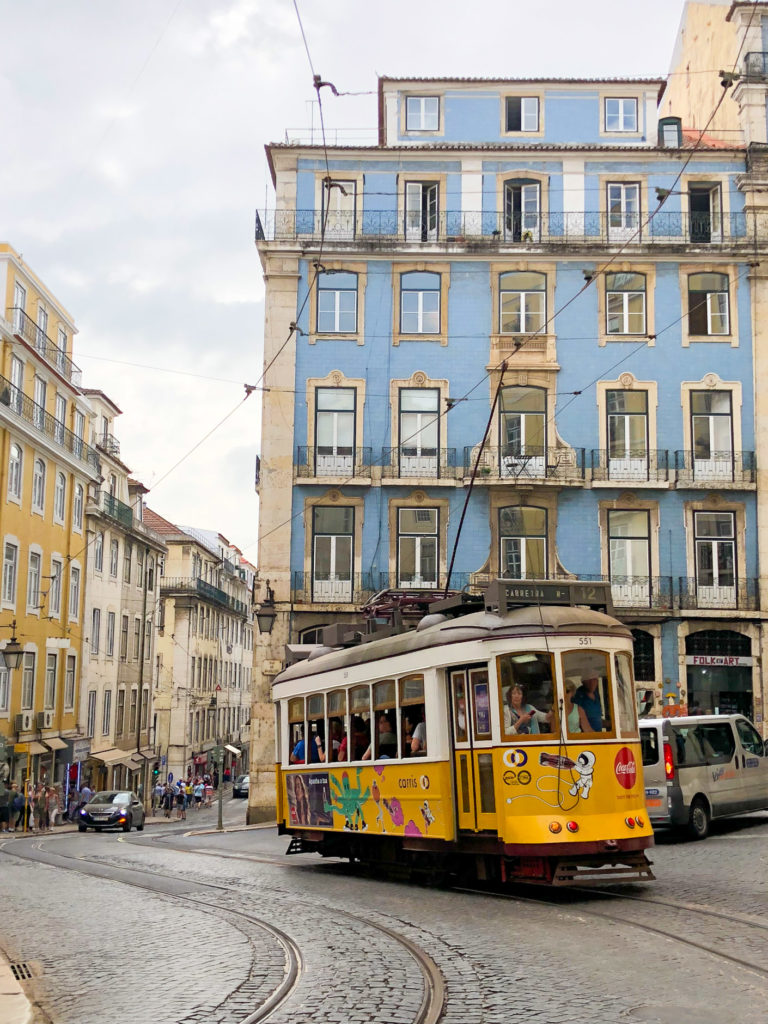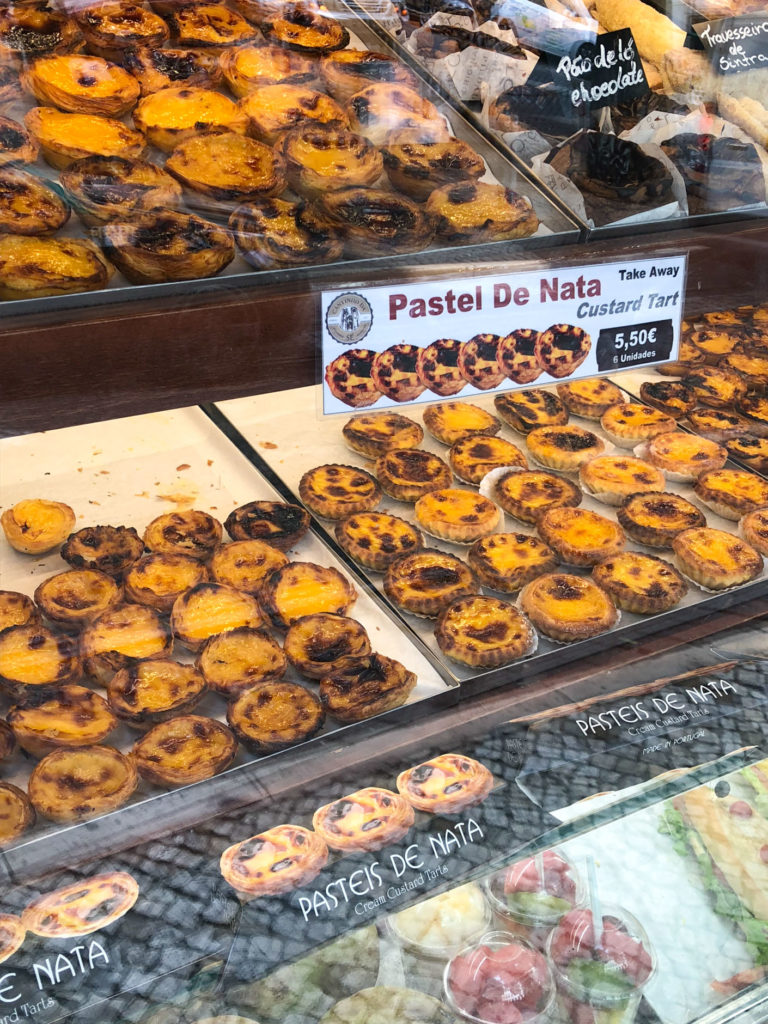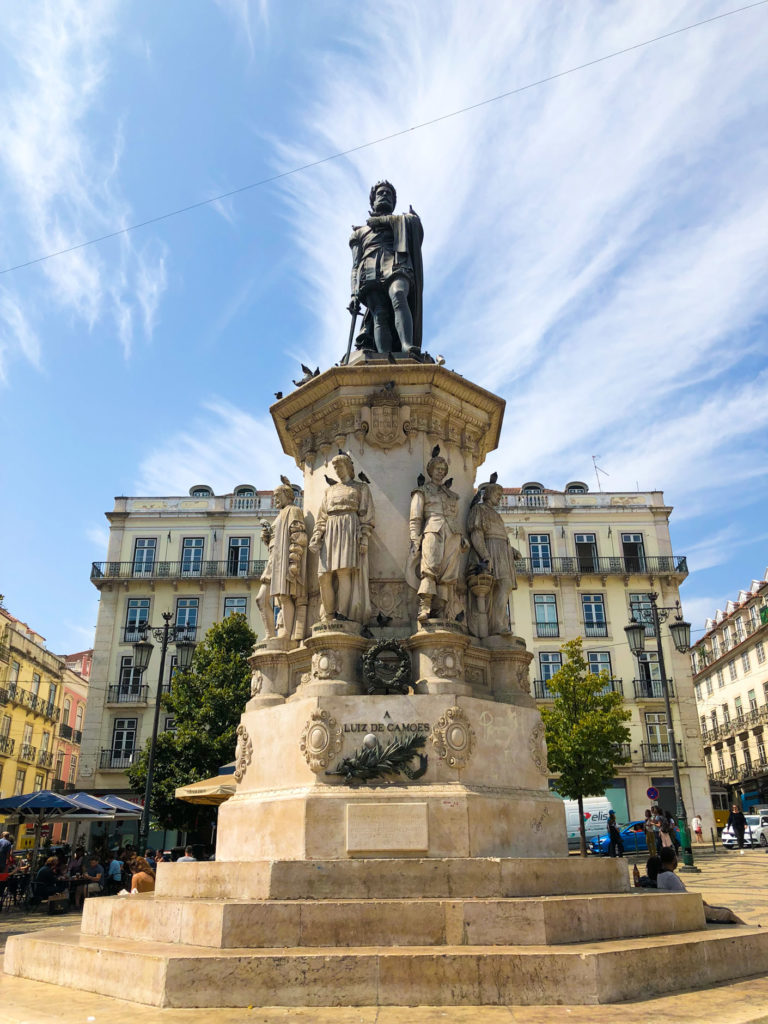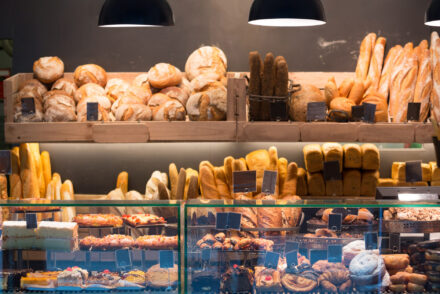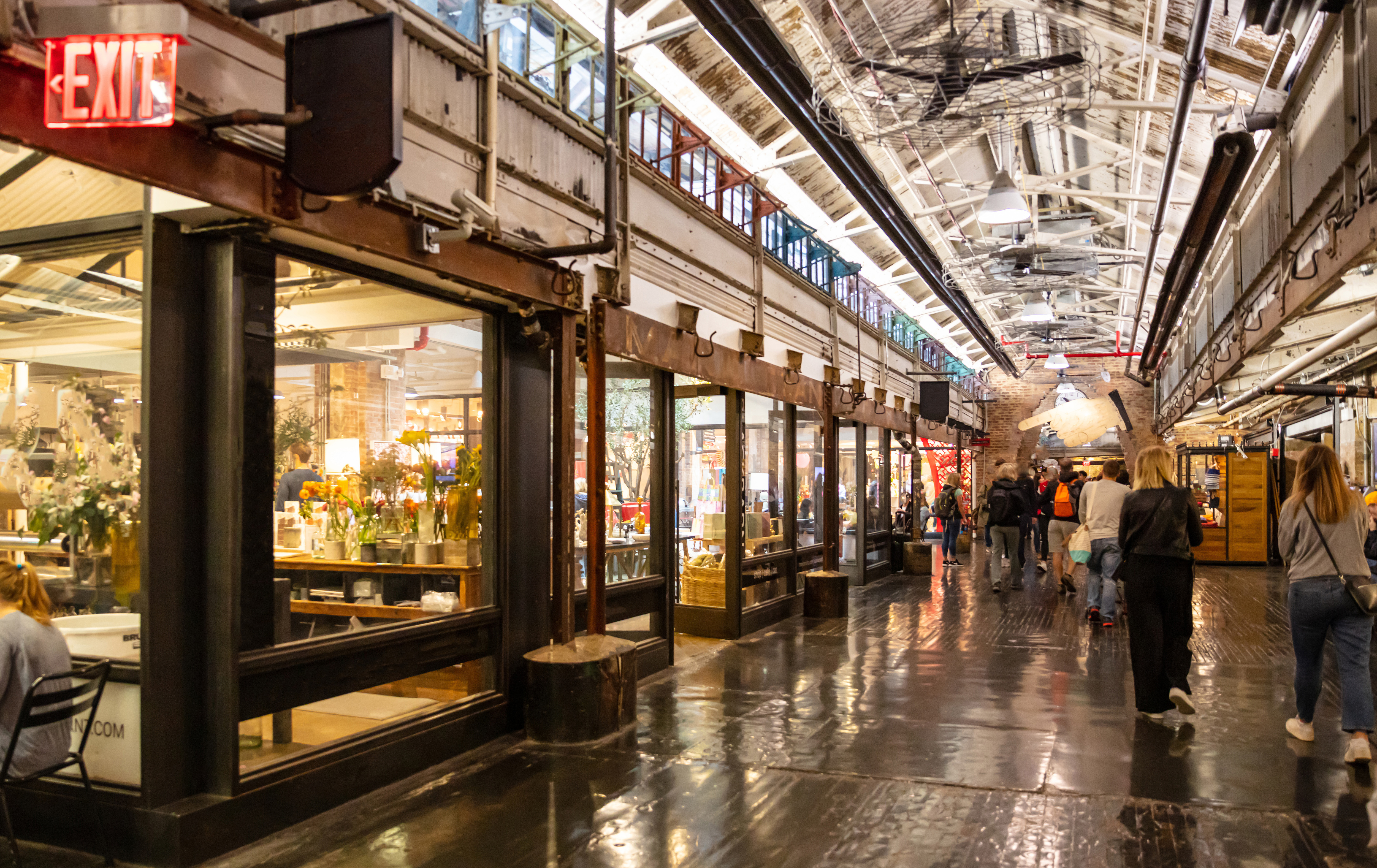With its ancient ruins, gothic architecture and its pre-revolutionary past still lingering in the memories of its older citizens, Lisbon is a city steeped in history. Since the fascist dictatorship was overthrown in the mid-70s the Portuguese capital has been a beacon for liberal, progressive values and a popular touristic destination. And combined with the general gastronomic awakening on the Iberian peninsular in the last decade, it is now very much a ‘foodie’ destination too.
Betwixt Lisbon’s famous ‘seven hills’ there’s a plethora of things to see and do: museums, galleries, vibrant nightlife and old-school trams that put the ‘fun’ into funicular. Also, coastal town Cascais is within easy reach and the stunningly beautiful Sintra is a mere 40 minute journey by a regular local train from Rossio station (seriously, go to Sintra). Porto and the Algarve are also just a couple of hours away, making Lisbon the perfect base for a visit to Portugal. But, as with all of Palate’s travel guides, we focus on the food and drink. This can never be, and doesn’t intend to be, exhaustive but will hopefully point you in the right direction when planning your eating out agenda. Let’s start with the local specialities…
Classic dishes and local cuisine
Thanks to Lisbon’s proximity to the Atlantic the city is blessed with an abundance of superlative seafood. Oddly though, the most popular dish doesn’t come from the local waters. Salt cod (“bacalhau”) is made according to an ancient method of preservation. It’s rather pungent but slightly more palatable in, say, a stew or a croquette. The Portuguese are obsessed with it and even have it for Christmas. No trip to Lisbon is complete without trying some.
Then there are the staple Portuguese sandwiches. The bifana is a sandwich filled with a marinated pork cutlet, whilst the prego is the beef alternative and often consumed after seafood (which presumably inspired Parsons’ wonderful steak sandwich dessert in London). Either of these are available at countless ‘grab and go’ outlets. Indeed, I enjoyed a bifana on the train to Sintra. Keeping with the meat theme, make sure you also try morcela (a blood sausage and very similar to the Spanish morcilla) and the lovely goat stew (“chanfana”).
Don’t worry about the calories. In Lisbon, the full workout you get from navigating the incessant hills, steps and cobbled streets is sufficient penance to pay
A lot of these, and more, are available in the Time Out Market. Time Out magazine branched out into the experiential ‘space’ and created its own market in 2014 – complete with food stalls, a cookery school, and bars aplenty near the Tagus River. It has been such a successful concept that Time Out will be rolling these out in other cities in the world in the next couple of years.
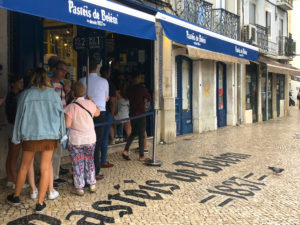
Pasteis de Belem – be prepared to queue
And then, of course, there is the pastel de nata. Perhaps by virtue of the EU’s free movement of people, and therefore ideas, the famous Portuguese custard tart is now as ubiquitous as the croissant in every independent coffee shop in the UK. We’ve all come to know and love these little beauties. Absolutely no-one can deny the unadulterated joy of sinking your teeth into that set eggy custard encased in flaky pastry. But don’t worry about the calories. In Lisbon, the full workout you get from navigating the incessant hills, steps and cobbled streets is sufficient penance to pay (indeed, my local bartender friend explained to me that Lisboans’ perfectly-formed posteriors are attributable to the city’s 3D terrain – naturally, I didn’t ask for evidence to prove such an hypothesis).
But where do you go for the original custard tart? The real deal? Pastéis de Belém, out in the western outskirts of Lisbon, is the birthplace of this legendary tart, so the story goes. In fact, they make them to a unique, secret recipe. But be prepared for queues. And tourists – all snapping away on their smartphones. There is both a ‘fast’ queue for take-away tarts and a ‘slow’ queue if you want to wait for a table (and I mean, a long wait). To be honest, unless you want to combine this with a visit to the Belém Tower, MAAT (the Museum of Art, Architecture and Technology) and perhaps LX Factory (see further below), I’d say give it a miss if you’re pushed for time. There are plenty of tarts to be had in central Lisbon (custard ones, for the avoidance of doubt).
It’s also worth mentioning another custardy speciality called pudim – a dessert I tried at A Travessa (more on which below). This is made with around 8 eggs, compressed like a neutron star. It’s like an intense crème caramel and rather lovely but best in small doses.
Mid-range eateries
One of the most wonderful things about this city is how affordable the food is. If you want to keep to the mid-range price point, the city has an excellent selection of restaurants.
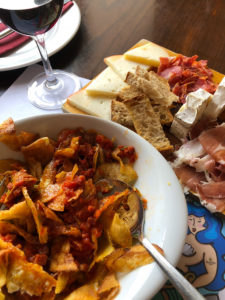
Portuguese ‘tapas’ at Tagide
It’s becoming fashionable – and indeed much more accessible for customers – to have casual dining off-shoots of established high-end restaurants. One example is Bistro 100 Maneiras, the casual younger sibling of chef Ljubomir Stanisic’s 100 Maneiras. Stanisic is somewhat of a celebrity chef in Portugal and he blends local ideas with pan-European and north African influences – so, quite a wide remit then. The bistro version has a small but well-formed bar which segues without warning into the restaurant area. The tables may have tablecloths and the cushions are plump, but it aims to be more laid-back with no stiff formality. Some beautiful beef stew croquettes were served with my aperitif, followed by a rack of lamb served in a Moroccan-style tagine, finishing with the “Life of Pie” – a kind of cheesecake with maple syrup and pecan nuts which was just a tad too sweet for my liking. On my visit, three courses, wine, coffee and service came to about £60.
Tágide is another restaurant with a casual alternative – in this case a Portuguese twist on tapas at very reasonable prices but the same wonderful view over the Lisboan rooftops enjoyed by the restaurant’s patrons upstairs. They also have a wine machine which allows you to pour your own glasses, using a kind of credit card that keeps a tab of how many glasses you’ve had.
Prado, in a former factory in Alfama, reminded me a little of Londrino in Bermondsey with its open kitchen, expansive space and sleek industrial look. Come here for some excellent small plates served with Vista Alegre cutlery (wonderful attention to detail). I had a very good lunch here, the lardo on toast and Iberico tenderloin being particularly memorable.
Finally, if you’re in the Principe Real district, there are plenty of eateries here: The Decadente and Restaurante Pão à Mesa both tried and tested dining spots where a decent meal will set you back around £30.
High-end and/or traditional
Both Jose Avillez and Ljubomir Stanisic continue to lead the charge for Portuguese fine dining. You may remember the late Anthony Bourdain – the Hemingway of international cuisine – interviewed them in ‘No Reservations’ around 2012. Since then, Avillez has branched out with Belcanto and earned two Michelin stars (you can read our full review here).
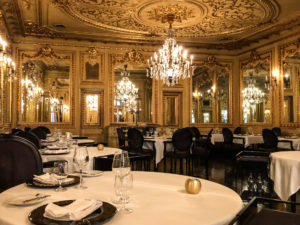
Inside Tavares
A Travessa is another ‘destination’ choice. Located in a former convent, it has a peaceful ambience, especially if you sit outside under the cloisters in the summer. Here I experienced lovely service and generous portions. The “degustation” starter was a feast in itself, including mackerel with fennel, salmon with tomatoes and crème fraiche, bread with olive tapenade, slices of roast pork, clams dripping in garlic sauce, and scrambled egg with mushrooms presented in a large metal tray and conveyed to my plate silver service style. I actually couldn’t believe that was just the starter. Oh, and crisps! Yes, crisps! The meal ended with the aforementioned pudim. My legs aching after my hike around Sintra earlier that day, my dinner at A Travessa was the perfect end to proceedings.
Finally in this section, a quick word about Tavares. This is apparently Lisbon’s oldest (and possibly grandest) restaurant. With its rococo interior, mirrors and chandeliers, it channels The Ritz, and seems to attract slightly older clientele who probably remember the Carnation Revolution vividly. Still, it tries to be attuned to contemporary tastes as far as possible. I particularly enjoyed the sous-vide slow-cooked egg in a pea soup and found the service here particularly attentive.
Drink
This is where Lisbon really shines. And in Lisbon drinking can be educational too. If the combination of scientific history and drinking ‘medicinal’ cocktails floats your boat, head to The Pharmacy Museum – a fascinating afternoon can be spent learning about the history of Portuguese medicine, and then you can reward yourself with a tonic afterwards.
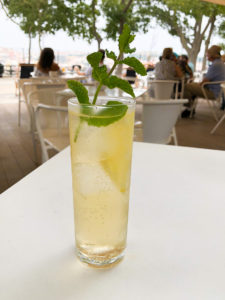
White port and tonic
Over in the western edge of the city, and in the shade of the 25 April bridge, is the hipster zone LX Factory. This little artistic community has a slight air of Copenhagen’s Christiana about it – liberal without being entirely lawless – with a good collection of wine bars, pubs and a very good bookshop.
Back in the centre, Pensão Amor is a short walk away from the Time Out Market. This former brothel is rather chic and colourful and they have a pole for dancing should you feel the urge. They also serve a decent Negroni.
For classic cocktails in a quirky environment look no further than Pavilhao Chines – the bar that time forgot. My Martini and Daiquiri here may not have been the best in the world, but this cavernous toy shop with staff in waistcoats harks back to a bygone age and is an experience in itself. For a slightly more modern take on classics, the bar at The Intercontinental is very good, if you don’t mind heading a bit out of the centre – ask for bar manager Hugo and you’ll be looked after.
The most impressive bar though has to be Cinco Lounge. This bar opened in 2004 and since then has become a template for everywhere else and a training ground for all decent bartenders in Portugal. Here I met mixology wizard Zé Robertson. As he puffed on cigarettes (no smoking ban it seems) and gave me free beers or shots between cocktails, he explained his philosophy and showed off his ‘roll’ technique. Their crowd-pleasing ‘Finders Keepers’ is served in a can which you have to open yourself. I had a wonderful evening here, talking nonsense with the staff and leaving around 4am. Whoops.
Finally, I cannot recommend enough two local specialities. First, ginjinha which is a liqueur made from ginja berries (a kind of sour cherry) and is both utterly delicious and dangerously addictive. Secondly, white port with tonic, served with a sprig of mint and a slice of lemon. This is available nearly everywhere, but this is especially good at the Memmo Alfama hotel with its panoramic view over the harbour. Sitting there, sipping my drink and reflecting on my trip, I was the happiest I had been in a long time. On my return to London I stock-piled white port in my fridge and each time I have some I’m reminded of my time in Lisbon. I might pour myself a glass now.
It’s relatively easy to fly to Lisbon from the UK and prices can be as low as £20 on the cheaper airlines. Alternatively, you can let life imitate art by getting the night train to Lisbon which runs from Hendaye on the French-Spanish border in the evening and arriving in Lisbon the following morning (a first class cabin is highly recommended for this – book tickets by Loco2 or see The Man In Seat 61 for further non-flying travel tips).
This travel guide was last updated in February 2019. All photos by J A Smith.


